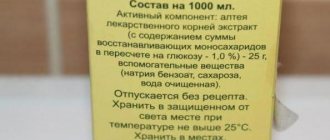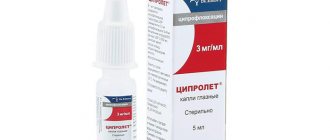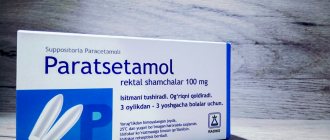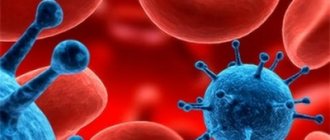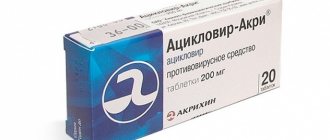Gestation is an important physiological period for a woman, during which any health problem that previously seemed insignificant can pose a threat to the unborn child. There is a noticeable weakening of the immune forces of the mother's body, so women begin to suffer more often from diseases caused by pathogens. Rovamycin during pregnancy can be prescribed in case of infectious pathology.
The prescription of any antibiotic should always be justified. Taking this group of drugs is associated with a considerable risk of adverse reactions, even in a relatively healthy body.
The problem of selecting a safe antibiotic becomes especially acute during pregnancy. To eliminate the risk of teratogenic effects (harmful effects on the fetus), before using the medicine, you must carefully read its properties indicated in the instructions.
Increased amount of amniotic fluid
Polyhydramnios is usually diagnosed after an ultrasound. It may be prescribed unscheduled if the gynecologist suddenly notices some signs - high blood pressure, a urinary tract infection suddenly appears, the stomach becomes larger than normal and swelling appears. If polyhydramnios is acute, an amniotomy will be prescribed to remove excess water. If it is chronic, it would be better to prolong the pregnancy until the due date and prescribe complex therapy. Is it possible to cure yourself at home using folk remedies? I strongly recommend that you follow your doctor's instructions and not use any herbal remedies or homeopathy.
Pharmacodynamics and pharmacokinetics
The antibacterial activity of Rovamycine is aimed at streptococci, staphylococci and enterococci. Some other microorganisms and strains also show sensitivity to it, provided there is a high concentration of the active substance in the body.
Spiramycin is characterized by rapid, but not complete absorption, amounting to 10-60%.
After oral or intravenous administration of the drug in an increased dosage every 8 hours, the maximum concentration of the substance is achieved on the 2nd day of therapy.
Penetration of spiramycin and accumulation in tissues and physiological fluids has been noted. The drug penetrates the placental barrier and enters breast milk. The antibiotic is excreted from the body rather slowly, as part of the bile, and even 10 days after cessation of treatment its concentration is determined in some organs. Metabolism of Rovamycin occurs in the liver, resulting in the formation of active metabolites.
pharmachologic effect
For tablets
From the gastrointestinal tract: nausea, vomiting, diarrhea and very rare cases of pseudomembranous colitis (<0.01%). Isolated cases of ulcerative esophagitis and acute colitis have been described. The possibility of developing acute damage to the intestinal mucosa in patients with AIDS when using high doses of spiramycin for cryptosporidiosis was also noted (2 cases in total).
From the liver: very rarely (<0.01%) - changes in liver function tests and the development of cholestatic hepatitis.
From the hematopoietic organs: very rarely (<0.01%) - the development of acute hemolysis (see “Contraindications”) and thrombocytopenia.
From the cardiovascular system: possible prolongation of the QT interval on the ECG.
Hypersensitivity reactions: skin rash, urticaria, itching; very rarely (<0.01%) - angioedema, anaphylactic shock.
For lyophilized powder for the preparation of solution for intravenous administration
Rarely occurring and moderately severe irritation along the vein, which only in exceptional cases may require discontinuation of treatment.
Skin allergic reactions.
Other: isolated cases of vasculitis, including Henoch-Schönlein purpura.
Common to both dosage forms
From the peripheral nervous system and central nervous system: transient paresthesia.
Combinations of levodopa and carbidopa: Due to inhibition of carbidopa absorption, plasma levodopa levels may be reduced. When co-administering spiramycin, clinical monitoring and some modification of the dosage of levodopa is necessary.
Lyophilized powder for the preparation of a solution for intravenous administration
Use with caution with ergot alkaloids.
Development of ventricular arrhythmias, in particular “torsade de pointes”. This severe arrhythmia can be caused by a number of antiarrhythmic and non-antiarrhythmic drugs. Hypokalemia that occurs when using potassium-removing diuretics, stimulant laxatives, amphotericium B (iv), corticosteroids, tetracosactide is a predisposing factor, as well as bradycardia with congenital or acquired prolongation of the QT interval. Intravenous administration of spiramycin can lead to the development of torsade de pointes.
When spiramycin is administered intravenously with drugs that cause bradycardia (calcium channel blockers: diltiazem, verapamil, beta-blockers, clonidine, guanfacine, digitalis alkaloids, cholinesterase inhibitors - donepezil, rivastigmine, tacrine, ambenonium chloride, galantamine, pyridostigmine, neostigmine), and Also, with drugs that reduce the level of potassium in the blood (potassium-removing diuretics, stimulant laxatives, amphotericin B (iv), corticosteroids, mineralocorticoids, tetracosactide), the risk of ventricular arrhythmias, in particular “torsade de pointes”, increases.
| Category ICD-10 | Synonyms of diseases according to ICD-10 |
| A39.0 Meningococcal meningitis | Meningeal infections |
| Meningitis meningococcal | |
| A46 Erysipelas | Erysipelas |
| J01 Acute sinusitis | Inflammation of the paranasal sinuses |
| Inflammatory diseases of the paranasal sinuses | |
| Purulent-inflammatory processes of the paranasal sinuses | |
| Infectious and inflammatory disease of ENT organs | |
| Sinus infection | |
| Combined sinusitis | |
| Exacerbation of sinusitis | |
| Acute inflammation of the paranasal sinuses | |
| Acute bacterial sinusitis | |
| Acute sinusitis in adults | |
| Subacute sinusitis | |
| Acute sinusitis | |
| Sinusitis | |
| J03.9 Acute tonsillitis, unspecified (angina agranulocytic) | Angina |
| Sore throat, alimentary-hemorrhagic | |
| Sore throat secondary | |
| Primary tonsillitis | |
| Sore throat follicular | |
| Sore throats | |
| Bacterial tonsillitis | |
| Inflammatory diseases of the tonsils | |
| Throat infections | |
| Catarrhal sore throat | |
| Lacunar tonsillitis | |
| Acute sore throat | |
| Acute tonsillitis | |
| Tonsillitis | |
| Acute tonsillitis | |
| Tonsillar tonsillitis | |
| Follicular tonsillitis | |
| Follicular tonsillitis | |
| J15.7 Pneumonia caused by Mycoplasma pneumoniae | Atypical pneumonia |
| Atypical pneumonia | |
| Mycoplasma pneumonia | |
| Primary atypical pneumonia | |
| Pneumonia Illinois | |
| Louisiana Pneumonia | |
| Mycoplasma pneumonia | |
| Primary atypical pneumonia | |
| J18 Pneumonia without specifying the pathogen | Alveolar pneumonia |
| Community-acquired pneumonia atypical | |
| Community-acquired pneumonia, non-pneumococcal | |
| Pneumonia | |
| Inflammation of the lower respiratory tract | |
| Inflammatory lung disease | |
| Lobar pneumonia | |
| Respiratory and lung infections | |
| Lower respiratory tract infections | |
| Cough due to inflammatory diseases of the lungs and bronchi | |
| Lobar pneumonia | |
| Lymphoid interstitial pneumonia | |
| Nosocomial pneumonia | |
| Exacerbation of chronic pneumonia | |
| Acute community-acquired pneumonia | |
| Acute pneumonia | |
| Focal pneumonia | |
| Pneumonia abscess | |
| Pneumonia bacterial | |
| Pneumonia lobar | |
| Pneumonia focal | |
| Pneumonia with difficulty in sputum discharge | |
| Pneumonia in patients with AIDS | |
| Pneumonia in children | |
| Septic pneumonia | |
| Chronic obstructive pneumonia | |
| Chronic pneumonia | |
| J42 Chronic bronchitis, unspecified | Allergic bronchitis |
| Asthmoid bronchitis | |
| Allergic bronchitis | |
| Asthmatic bronchitis | |
| Chronic bronchitis | |
| Inflammatory disease of the respiratory tract | |
| Bronchial disease | |
| Qatar smoker | |
| Cough due to inflammatory diseases of the lungs and bronchi | |
| Exacerbation of chronic bronchitis | |
| Recurrent bronchitis | |
| Chronic bronchitis | |
| Chronic obstructive pulmonary diseases | |
| Chronical bronchitis | |
| Chronic bronchitis of smokers | |
| Chronic spastic bronchitis | |
| K05.2 Acute periodontitis | Periodontal diseases |
| Periodontitis | |
| Acute periodontitis | |
| Periodontal disease complicated by gingivitis | |
| Pericoronitis | |
| L01 Impetigo | Bullous impetigo |
| Vulgar impetigo | |
| Contagious impetigo | |
| Common impetigo | |
| Simple contact dermatitis complicated by impetigo | |
| Streptococcal impetigo | |
| L08.0 Pyoderma | Atheroma festering |
| Pustular dermatoses | |
| Pustular skin lesions | |
| Purulent allergic dermatopathies | |
| Purulent skin infections | |
| Infected atheroma | |
| Mycoses complicated by secondary pyoderma | |
| Ostiofolliculitis | |
| Pyodermatitis | |
| Pyoderma | |
| Superficial pyoderma | |
| Staphylococcal sycosis | |
| Staphyloderma | |
| Streptoderma | |
| Streptostaphyloderma | |
| Chronic pyoderma | |
| L08.1 Erythrasma | Erythrasma |
| L98.9 Lesions of skin and subcutaneous tissue, unspecified | Adiponecrosis |
| Atonic skin | |
| Skin diseases | |
| Blister | |
| Inflammatory soft tissue disease | |
| Inflammatory processes of epithelial tissues | |
| Degenerative changes in the skin and mucous membranes | |
| Degenerative changes in the skin and mucous membranes | |
| Excessive granulation | |
| Thinning skin | |
| Skin disease | |
| Skin diseases | |
| Lipedema | |
| Skin maceration | |
| Minor skin lesions | |
| Local non-infectious processes of the skin and soft tissues | |
| Violation of skin structure | |
| Skin dysfunction | |
| Skin disorders | |
| Superficial crack and abrasion of the skin | |
| Increased peeling of the skin | |
| Skin lesions | |
| Skin erosion | |
| M00.9 Pyogenic arthritis, unspecified (infectious) | Joint infection |
| Septic arthritis | |
| M79.0 Rheumatism, unspecified | Degenerative rheumatic disease |
| Degenerative and rheumatic tendon diseases | |
| Degenerative rheumatic diseases | |
| Localized forms of soft tissue rheumatism | |
| Rheumatism | |
| Rheumatism with a pronounced allergic component | |
| Rheumatism articular and extra-articular | |
| Rheumatic attack | |
| Rheumatic complaints | |
| Rheumatic diseases | |
| Rheumatic diseases of the intervertebral disc | |
| Rheumatic disease | |
| Rheumatic spine disease | |
| Rheumatoid diseases | |
| Relapses of rheumatism | |
| Articular and extra-articular rheumatism | |
| Articular and muscular rheumatism | |
| Articular rheumatism | |
| Articular syndrome in rheumatism | |
| Chronic rheumatic pain | |
| Chronic articular rheumatism | |
| M86.9 Osteomyelitis, unspecified | Purulent wounds with osteomyelitis |
| Staphylococcal osteomyelitis | |
| N49.9 Inflammatory diseases of unspecified male genital organ | Genital infection |
| N73.9 Inflammatory diseases of the female pelvic organs, unspecified | Abscess of the pelvic organs |
| Bacterial diseases of the urogenital tract | |
| Bacterial infections of the genitourinary system | |
| Bacterial infections of the pelvic organs | |
| Intrapelvic infections | |
| Inflammation in the area of the cervix | |
| Pelvic inflammatory disease | |
| Pelvic inflammatory disease | |
| Inflammatory gynecological diseases | |
| Inflammatory diseases of the female pelvic organs | |
| Inflammatory diseases of the pelvic organs | |
| Inflammatory diseases of the pelvic organs | |
| Inflammatory infections in the pelvic area | |
| Inflammatory processes in the pelvis | |
| Gynecological infection | |
| Gynecological infections | |
| Gynecological infectious diseases | |
| Purulent-inflammatory diseases of the pelvic organs | |
| Infections of female genital organs | |
| Infections of the pelvic organs in women | |
| Pelvic infections | |
| Infections of the urogenital tract | |
| Infectious diseases of the reproductive system | |
| Infectious diseases of the genital organs | |
| Infection of female genital organs | |
| Metritis | |
| Acute infection of the female genital organs | |
| Acute inflammatory disease of the pelvic organs | |
| Pelvic infection | |
| Tuboovarian inflammation | |
| Chlamydial gynecological infections | |
| Chronic inflammatory diseases of the pelvic organs | |
| Chronic inflammatory diseases of the appendages | |
| Chronic infections of the female genital organs |
We invite you to read: Consequences of failure to comply with the settlement agreement
Interaction
The use of the drug Rovamycin 3,000,000 IU simultaneously with Levodopa and Carbidopa may reduce the level of Levodopa in plasma. Therefore, clinical monitoring and dosage adjustment are required.
When using a solution for intravenous administration together with ergot alkaloids, maximum caution is required.
Combination with antiarrhythmic and non-antiarrhythmic drugs can lead to the development of ventricular arrhythmia. Taking potassium-sparing diuretics, corticosteroids, laxatives and tetracosactide can lead to hypokalemia and bradycardia. Also, the development of bradycardia can be caused by simultaneous use of the drug with calcium channel blockers, for example, Diltiazem, Verapamil, beta-blockers, Clonidine, Guanfacine, some cholinesterase inhibitors - Donepezil, Rivastigmine, Tacrine, Galantamine.
Therefore, before prescribing this drug, it is necessary to eliminate hypokalemia. It is also regularly required to monitor general condition, electrolyte levels, and ECG.
When the antibiotic is used together with levodopa, active absorption may be inhibited. The level of levodopa in the blood plasma will decrease, so it is necessary to monitor and adjust the dosage of levodopa. When using an antibiotic, multiple cases of increased activity of indirect coagulants have been reported, which can lead to internal bleeding. Factors influencing the increased risk of bleeding also include the age of the patient, the course of the disease, and the clinical picture of the disease.
Treatment of ureaplasma infection of the urogenital tract
What can you tell me? What to warn about, what to console? What does your experience show? Are babies born to mothers with the same problems healthy (am I not the only one?). Thank you very much! Best regards, Olga. Olga, hello! Honestly, I didn’t find anything at all dangerous in your descriptions. It’s not so much all the listed microbes and thickening of the placenta that are dangerous, but your stress. There are two known biovars of ureaplasma - Parvo and T960, which are divided into 14 serovars. Recent advances in molecular biology in the study of DNA and ribosomal RNA of ureaplasmas have allowed some authors (F. Kong et al. 2000) to abandon the classical classification and divide all ureaplasmas into two species - Ureaplasma urealyticum (former biovar T960) and Ureaplasma parvum (former biovar Parvo) . As mentioned above, the question of the role of ureaplasma in the etiology and pathogenesis of diseases of the urogenital tract has not yet been resolved.
Rovamycin price, where to buy
You can buy Rovamycin 1.5 million IU at a cost of 900-1100 rubles.
The price of Rovamycin 3 million IU varies between 1500-1800 rubles.
The price of Rovamycin 3,000,000 IU in Ukraine is from 214 UAH.
- Online pharmacies in RussiaRussia
- Online pharmacies in UkraineUkraine
- Online pharmacies in KazakhstanKazakhstan
ZdravCity
- Rovamycin tablets p.p.o.
3 million IU 10 pcs. Sanofi-Aventis S.P.A. RUB 1,712 order - Rovamycin tablets p.p.o. 1.5 million ME 16 pcs. Sanofi-Aventis S.P.A.
RUB 1,135 order
Pharmacy Dialogue
- Rovamycin (table 3MME No. 10)Sanofi Aventis
RUB 1,652 order
- Rovamycin (tablet 1.5 MME No. 16) Famar Lyon
RUR 1,138 order
- Rovamycin tablets 1.5MME No. 16Aventis-Famar
RUB 1,155 order
Europharm* 4% discount using promo code medside11
- Rovamycin 1.5 million iu 16 tabletsSanofi Aventis SpA Italia
RUB 1,072 order
- Rovamycin 3 million IU 10 tabletsSanofi Aventis SpA Italia
1830 rub. order
show more
Pharmacy24
- Rovamycin 1.5 million units No. 16 Sanofi-Aventis S.p.A., Italy/Sanofi S.P.A. Italy
209 UAH order - Rovamycin 3 million units No. 10 tablets Sanofi-Aventis S.p.A., Italy/Sanofi S.P.A. Italy
193 UAH order
PaniPharmacy
- Rovamycin tablets Rovamycin tablets. 3000000ME No. 10 France, Famar Lyon
215 UAH order
- Rovamycin tablets Rovamycin tablets. 1500000ME No. 16 France, Famar Lyon
225 UAH order
show more
Composition and release form
| Film-coated tablets | 1 table |
| spiramycin | 1.5 million IU |
| 3 million IU | |
| excipients: colloidal anhydrous silicon; magnesium stearate; pregelatinized starch; hydroxypropylcellulose; croscarmellose sodium (sodium carboxymethylcellulose); MCC |
in a blister 8 (for tablets of 1.5 million IU) and 5 pcs. (for tablets 3 million IU); There are 2 blisters in a cardboard box.
| Lyophilized powder for the preparation of solution for intravenous administration | 1 fl. |
| spiramycin | 1.5 million IU |
1 bottle in a box.
Tablets with a dosage of 1.5 million IU: biconvex round tablets, film-coated, white or white with a creamy tint. One side is engraved "RPR 107".
Tablets with a dosage of 3 million IU: biconvex round tablets, coated, white with a creamy tint. On one side there is an engraving “ROVA 3”.
Reviews about Rovamycin
This antibiotic is widely used in clinical practice. Therefore, reviews of Rovamycin are found on various medical forums. At the same time, users confirm its high efficiency.
Quite often you can find reviews about Rovamycin during pregnancy. It is prescribed for the treatment of infectious diseases in pregnant women. This is quite acceptable, since studies have not shown the likelihood of developing a teratogenic effect. That is, taking the drug does not cause fetal pathologies or mutations.
Patients often ask whether children can take the drug. But as indicated in the instructions, tablets can be taken by young patients from 3 years old, and Rovamycin 3 million IU - only from 18 years old, like the solution for intravenous administration.
Sometimes there are reports of side effects developing during treatment. In most cases, they manifest themselves in the form of allergic reactions, for example, itching, hives, irritation and others. In some cases, it is described that treatment was not helpful, for example, with chlamydia.
Thus, it can be understood that the drug helps cure infectious diseases only with an individual approach. Each disease has a description, symptoms and diagnostic signs, but their causative agent and sensitivity to a specific drug can only be determined on the basis of thorough laboratory tests.
Unfortunately, such studies are rarely performed in medical practice. Therefore, there are situations when treatment is useless. It is important that a suitable antibiotic is prescribed, as well as other concomitant treatments. Conducting a timely study makes it possible to identify not only sensitivity to the drug, but also to establish a sufficient dosage that will ensure maximum effect and will not cause unwanted effects.
Pharmacodynamics
- usually sensitive microorganisms: minimum inhibitory concentration (MIC) ≤1 mg/l. More than 90% of strains are sensitive: streptococci (including Streptococcus pneumoniae), methicillin-sensitive and methicillin-resistant staphylococci, enterococci, Rhodococcus equi, Branhamella catarrhalis, Bordetella pertussis, Helicobacter pylori, Campylobacter jejuni, Legionella spp.
, Corynebacterium diphtheriae, Moraxella spp., Mycoplasma pneumoniae, Coxiella spp., Chlamydia spp., Treponema pallidum, Borrelia burgdorferi, Leptospira spp., Propionibacterium acnes, Actinomyces, Eubacterium, Porphyromonas, Mobiluncus, Bacteroides, Peptostreptococcus, Prevotella, Toxoplasma gondii (in vitro and in vivo.), Bacillus cereus;
- moderately sensitive microorganisms: the antibiotic is moderately active in vitro. Positive results can be observed when antibiotic concentrations at the site of inflammation are higher than the MIC (see the “Pharmacokinetics” field). Neisseria gonorrhoeae, Clostridium perfringens, Ureaplasma urealyticum;
- resistant microorganisms (MIC >4 mg/l): at least 50% of strains are resistant: methicillin-resistant staphylococci, Enterobacter spp., Pseudomonas spp., Acinetobacter, Nocardia asteroides, Fusobacterium, Haemophilus spp., Mycoplasma hominis.
Rovamycin
pharmachologic effect
Antibiotic from the macrolide group.
The mechanism of antibacterial action is due to inhibition of protein synthesis in the microbial cell due to binding to the 50S ribosomal subunit. Sensitive microorganisms
(MIC < 1 mg/l): gram-positive aerobes - Bacillus cereus, Corynebacterium diphtheriae, Enterococcus spp., Rhodococcus equi, Staphylococcus spp. (methicillin-sensitive and methicillin-resistant strains), Streptococcus B, unclassified streptococcus, Streptococcus pneumoniae, Streptococcus pyogenes; gram-negative aerobes - Bordetella pertussis, Branhamella catarrhalis, Campylobacter spp., Legionella spp., Moraxella spp.; anaerobes - Actinomyces spp., Bacteroides spp., Eubacterium spp., Mobiluncus spp., Peptostreptococcus spp., Porphyromonas spp., Prevotella spp., Propionibacterium acnes; various - Borrelia burgdorferi, Chlamydia spp., Coxiella spp., Leptospira spp., Mycoplasma pneumoniae, Treponema pallidum, Toxoplasma gondii.
Moderately sensitive microorganisms
(the antibiotic is moderately active in vitro at antibiotic concentrations at the site of inflammation ≥ 1 mg/l, but < 4 mg/l): gram-negative aerobes - Neisseria gonorrhoeae; aerobes - Clostridium perfringens; different - Ureaplasma urealyticum.
Resistant microorganisms
(MIC>4 mg/l; at least 50% of strains are resistant): gram-positive aerobes - Corynebacterium jekeium, Nocardia asteroides; gram-negative aerobes - Acinetobacter spp., Enterobacter spp., Haemophilus spp., Pseudomonas spp.; anaerobes - Fusobacterium spp.; different - Mycoplasma hominis.
Pharmacokinetics
Suction
Absorption of spiramycin occurs quickly, but incompletely, with great variability (from 10% to 60%). After taking Rovamycin orally at a dose of 6 million IU, the Cmax of spiramycin in plasma is about 3.3 μg/ml. Eating does not affect absorption.
Distribution
Plasma protein binding is low (approximately 10%). Vd approximately 383 l. The drug penetrates well into saliva and tissues (the concentration in the lungs is 20-60 mcg/g, in the tonsils - 20-80 mcg/g, in infected sinuses - 75-110 mcg/g, in the bones - 5-100 mcg/g) . 10 days after the end of treatment, the concentration of spiramycin in the spleen, liver, and kidneys is 5-7 mcg/g.
Spiramycin penetrates and accumulates in phagocytes (neutrophils, monocytes and peritoneal and alveolar macrophages). In humans, drug concentrations inside phagocytes are quite high. This explains the effectiveness of spiramycin against intracellular bacteria.
Penetrates the placental barrier (the concentration in the fetal blood is approximately 50% of the concentration in the maternal blood serum). Concentrations in placental tissue are 5 times higher than corresponding concentrations in serum. Excreted in breast milk.
Spiramycin does not penetrate into the cerebrospinal fluid.
Metabolism and excretion
Spiramycin is metabolized in the liver to form active metabolites with an unknown chemical structure.
T1/2 from plasma is approximately 8 hours. It is excreted mainly in bile (concentration 15-40 times higher than in serum). Renal excretion is approximately 10% of the administered dose. The amount of the drug excreted through the intestines (with feces) is very small.
Indications
Infectious and inflammatory diseases caused by microorganisms sensitive to the drug:
- acute and chronic pharyngitis caused by beta-hemolytic streptococcus A (as an alternative to treatment with beta-lactam antibiotics, especially in case of contraindications to their use);
— acute sinusitis (given the sensitivity of the microorganisms most often causing this pathology, the use of Rovamycin® is indicated in case of contraindications to the use of beta-lactam antibiotics);
- acute and chronic tonsillitis caused by microorganisms sensitive to spiramycin;
- acute bronchitis caused by a bacterial infection that develops after acute viral bronchitis;
- exacerbation of chronic bronchitis;
— community-acquired pneumonia in patients without risk factors for an unfavorable outcome, severe clinical symptoms and clinical signs of pneumococcal etiology of pneumonia;
- pneumonia caused by atypical pathogens (such as Chlamydia pneumoniae, Chlamydia trachomatis, Mycoplasma pneumoniae, Legionella spp.) or suspicion of it (regardless of the severity and the presence or absence of risk factors for an unfavorable outcome);
- infections of the skin and subcutaneous tissue, including impetigo, impetiginization, ecthyma, infectious dermohypodermatitis (especially erysipelas), secondary infected dermatoses, erythrasma;
— oral infections (including stomatitis, glossitis);
- non-gonococcal infections of the genital organs;
— toxoplasmosis, incl. during pregnancy;
- infections of the musculoskeletal system and connective tissue, including periodontium.
Prevention of relapses of rheumatism in patients with allergies to beta-lactam antibiotics.
Eradication of Neisseria meningitidis from the nasopharynx (if rifampicin is contraindicated) for the prevention (but not treatment) of meningococcal meningitis:
— in patients after treatment and before leaving quarantine;
- in patients who, within 10 days before hospitalization, were in contact with persons who secreted Neisseria meningitidis with saliva into the environment.
Dosage regimen
The drug is taken orally.
For adults
prescribe 2-3 tablets. 3 million IU or 4-6 tablets. 1.5 million IU (i.e. 6-9 million IU) per day. The daily dose is divided into 2 or 3 doses. The maximum daily dose is 9 million IU.
In children and adolescents aged 6 to 18 years
Only 1.5 million IU tablets should be used.
In children over 6 years old
the daily dose ranges from 150-300 thousand IU per kg of body weight, which is divided into 2 or 3 doses up to 6-9 million IU.
The maximum daily dose in children is 300 thousand IU per kg of body weight, but if the child’s body weight is more than 30 kg,
it should not exceed 9 million IU
To prevent meningococcal meningitis,
adults
are prescribed 3 million IU 2 times a day for 5 days,
children
- 75 thousand IU/kg body weight 2 times a day for 5 days.
Patients with impaired renal function
Due to the insignificant renal excretion of spiramycin, no dose adjustment is required.
The tablets are taken orally with a sufficient amount of water.
Side effect
From the digestive system:
nausea, vomiting, diarrhea; very rarely (<0.01%) - pseudomembranous colitis, changes in liver function tests, cholestatic hepatitis; in isolated cases - ulcerative esophagitis and acute colitis. The possibility of developing acute damage to the intestinal mucosa in patients with AIDS when using spiramycin in high doses for cryptosporidiosis was also noted (2 cases in total).
From the nervous system:
in some cases - transient paresthesia.
From the hematopoietic system:
very rarely (<0.01%) - acute hemolysis, thrombocytopenia.
From the cardiovascular system:
in isolated cases - prolongation of the QT interval on the ECG (several cases have been described only after intravenous administration of the drug to newborns).
Allergic reactions:
skin rash, urticaria, itching; very rarely (<0.01%) - angioedema, anaphylactic shock.
From the immune system:
in some cases - vasculitis, including Henoch-Schönlein purpura.
For the skin and subcutaneous tissues:
very rarely - acute generalized exanthematous pustulosis.
Contraindications
- lactation period;
— deficiency of glucose-6-phosphate dehydrogenase (risk of developing acute hemolysis);
- children's age (for tablets 1.5 million IU - up to 3 years, for tablets 3 million IU - up to 18 years);
- hypersensitivity to the components of the drug.
Carefully _
Rovamycin® is prescribed for bile duct obstruction and liver failure.
Pregnancy and lactation
Rovamycin® can be prescribed during pregnancy according to indications.
There is extensive experience with the use of the drug Rovamycin® during pregnancy. A decrease in the risk of transmitting toxoplasmosis to the fetus during pregnancy is observed from 25% to 8% when using the drug in the first trimester, from 54% to 19% in the second trimester, and from 65% to 44% in the third trimester. No teratogenic or fetotoxic effects were observed.
When prescribing Rovamycin® during lactation, breastfeeding should be stopped, since spiramycin may pass into breast milk.
special instructions
During treatment with the drug in patients with liver disease, it is necessary to periodically monitor its function.
If, at the beginning of treatment, generalized erythema and pustules occur, accompanied by high body temperature, acute generalized exanthematous pustulosis should be assumed; if such a reaction occurs, then treatment should be stopped, and further use of spiramycin, both in monotherapy and in combination, is contraindicated.
Use in pediatrics
Tablets of 3 million IU are not used in children due to the difficulty of swallowing them due to the large diameter of the tablets and the risk of airway obstruction.
Impact on the ability to drive vehicles and operate machinery
There is no information about the negative effect of the drug on the ability to drive a car or engage in other potentially hazardous activities. However, the severity of the patient's condition, which may affect attention and speed of psychomotor reactions, should be taken into account. Therefore, the decision about the possibility of driving a car or engaging in other potentially hazardous activities for a particular patient should be made by the attending physician.
Overdose
There are no known cases of spiramycin overdose.
Symptoms:
possible - nausea, vomiting, diarrhea. Cases of prolongation of the QT interval that resolves when the drug is discontinued have been observed in neonates receiving high doses of spiramycin or after intravenous administration of spiramycin in patients predisposed to prolongation of the QT interval.
Treatment:
in case of an overdose of spiramycin, ECG monitoring is recommended to determine the duration of the QT interval, especially in the presence of risk factors (hypokalemia, congenital prolongation of the QT interval, simultaneous use of drugs that prolong the duration of the QT interval and cause the development of ventricular tachycardia of the “pirouette” type). There is no specific antidote. If an overdose of spiramycin is suspected, symptomatic therapy is recommended.
Drug interactions
Inhibition of carbidopa absorption by spiramycin with a decrease in plasma levodopa concentrations. When prescribing spiramycin simultaneously, clinical monitoring and dose adjustment of levodopa is necessary.
Numerous cases of increased activity of indirect anticoagulants in patients taking antibiotics have been recorded. The type of infection or severity of the inflammatory reaction, age and general condition of the patient are predisposing risk factors. Under these circumstances, it is difficult to determine the extent to which the infection itself or its treatment plays a role in altering MHO. However, when using some groups of antibiotics, this effect is observed more often, in particular when using fluoroquinolones, macrolides, cyclines, the combination of sulfamethoxazole + trimethoprim, and some cephalosporins.
Conditions for dispensing from pharmacies
The drug is available with a prescription.
Storage conditions and periods
The drug should be stored out of the reach of children at a temperature not exceeding 25°C. The shelf life for tablets of 1.5 million IU is 3 years, for tablets of 3 million IU is 4 years.
How to take Rovamycin for pregnant women?
• Since antibiotics do not act on viruses, there is no point in treating influenza, acute respiratory viral infections and acute respiratory infections with them. These drugs are also not suitable for “bringing down” a high temperature. In case of intestinal disorder, antibiotics are also not required in most cases. • Over more than half a century of the existence of antibiotics, many varieties have been invented. All of them act on different types of bacteria and are not indifferent to the body to varying degrees.
The dosage and duration of treatment with Rovamycin during pregnancy is determined solely by the doctor. According to the instructions, adult patients take tablets according to the following regimen:
- one tablet 2-3 times a day, if the spiramycin content is 3 million IU;
- 2 tablets 2-3 times a day with an active substance content of 1.5 million IU.
We suggest you read: Dismissal of a temporary employee who is pregnant
The maximum amount of spiramycin taken per day should not exceed 9 million IU.
The tablet is taken with plenty of water. It is better to take the drug at the same time of day, with approximately equal intervals between them, for example, at 7 am, 2 pm and 9 pm daily.
If the drug is prescribed in the form of a lyophilisate, Rovamycin injections are given at 500 mg every 8 hours. In serious cases, the dose is increased to 1 gram, the time interval remains the same.
Rovamycin during pregnancy - reviews on the use of the drug
- Anna: “In the first trimester I was taken into care, but in the hospital I also got sick. As a result, sinusitis developed. The doctor prescribed Rovamycin. The drug helped very quickly. Additionally, I washed my nose with furatsilin and dripped Nazivin. I am very pleased with the result.
- Julia: “During the tests during registration, gardnerella, candida and ureaplasma urealyticum were identified. Treatment was carried out at week 16 with Rovamycin. Side effects included a metallic taste in the mouth. As a result, ureaplasma remains. For thrush, additional antifungal suppositories were prescribed. I think the treatment is ineffective. You shouldn’t take an antibiotic without a sensitivity test.”
- Elena: “At the 5th month, ureaplasma was discovered. I took Rovamycin with my husband. I didn’t experience any side effects. The treatment helped."
- Inga: “At the 8th month I fell ill with bronchitis. I took a course of Rovamycin as prescribed by the doctor. She recovered quickly. There were no side effects. The child was born healthy."
- Irina: “At 10 weeks I was hospitalized with abruption. Leukocytes began to increase in the blood. Penicillin didn't help. We switched to Rovamycin. After just 2 days, the number of leukocytes began to decrease. Everything worked out, the baby was saved.”
Pharmacokinetics
Absorption of spiramycin occurs quickly, but not completely, with great variability (from 10 to 60%).
Distribution. After oral administration of spiramycin at a dose of 6 million IU, Cmax in plasma is about 3.3 mcg/ml. After intravenous administration at a dose of 1.5 million IU by one-hour infusion, Cmax in plasma is 2.3 mcg/ml. With the administration of 1.5 million IU of spiramycin every 8 hours, the equilibrium concentration is achieved by the end of the second day (Cmax - about 3 μg/ml and Cmin - about 0.5 μg/ml).
Spiramycin penetrates and accumulates in phagocytes (neutrophils, monocytes, peritoneal and alveolar macrobacteriophages). In humans, drug concentrations inside phagocytes are quite high. These properties explain the effects of spiramycin on intracellular bacteria. Spiramycin does not penetrate into the cerebrospinal fluid, but diffuses into breast milk.
Penetrates the placental barrier (the concentration in the fetal blood is approximately 50% of the concentration in the maternal blood serum). Concentrations in placental tissue are 5 times higher than corresponding concentrations in serum. Distribution volume: approximately 383 liters. The drug penetrates well into saliva and tissues (concentration in the lungs - 20-60 µg/g, tonsils - 20-80 µg/g, infected sinuses - 75-110 µg/g, bones - 5-100 µg/g).
Biotransformation. Spiramycin is metabolized in the liver to form active metabolites with an unknown chemical structure.
Excretion. It is excreted mainly in bile (concentrations are 15–40 times higher than in serum). Renal excretion of active spiramycin is (from the administered dose): when taken orally - about 10%; with intravenous administration - about 14%. T1/2 after oral administration of 3 million IU of spiramycin is approximately 8 hours;
Effect of the drug
Rovamycin is one of the antibiotics that is not created synthetically. The active ingredient of the drug is spiramycin. This compound is derived from the actinomycete Streptomyces ambofaciens, a species of bacteria that forms a branching network similar to mycelium as it grows.
According to the mechanism of action, Rovamycin is a bacteriostatic drug: the drug blocks the synthesis of protein molecules of the microorganism. This leads to a rapid stop in the growth and reproduction of the infectious pathogen both in the early stages and during the long course of the disease. Spiramycin has a high affinity for tissue cells, so its content in plasma after administration is relatively low.
The high effectiveness of the antibiotic is explained by a scientific fact called the “spiramycin paradox.” Even if in vitro the sensitivity of bacteria to the drug was low, the static effect in relation to the same infectious pathogen increases significantly after entering the patient’s body.
While in a tissue cell, spiramycin does not lose its activity, since it does not undergo restructuring and subsequent breakdown (this occurs only in the liver). For this reason, Rovamycin is one of the drugs of choice in the treatment of intracellular infections during pregnancy.
The spectrum of action of this antibiotic is quite wide. It has a good bacteriostatic effect against some streptococcal and staphylococcal diseases. Spiramycin is active against such a dangerous pathogen as meningococcus.
The drug suppresses the growth and reproduction of whooping cough and diphtheria bacilli. Clostridia, Legionella and Leptospira are highly sensitive to Rovamycin. Infections caused by chlamydia and toxoplasma can be treated with this antibiotic. Mycoplasma and Haemophilus influenzae are also included in the spectrum of activity of spiramycin.
However, the drug is not universal. It is ineffective against enterobacteria and acinetobacteria. There is cross-resistance between the antibiotic in question and Erythromycin: a number of pathogens are equally insensitive to these two drugs.
The instructions indicate that not the entire amount of Rovamycin taken is absorbed: depending on a number of factors (for example, food intake), the bioavailability of the drug ranges from 10 to 60%. The antibiotic does not affect the composition of the cerebrospinal fluid, since the blood-brain barrier remains impenetrable to it. It penetrates into the lung, bone and other tissues of the body.
After administration, spiromycin is found in saliva for some time, and during lactation - in breast milk. The active substance of the drug can be detected in tissues even after 10 days (due to its high affinity for them). Rovamycin does not affect the kidneys: most of it is excreted along with bile.
Indications for the drug Rovamycin®
Pills
infectious diseases caused by sensitive microorganisms, especially ENT organs (including tonsillitis, sinusitis), lower respiratory tract (acute community-acquired pneumonia, including pneumonia caused by atypical microorganisms, exacerbation of chronic bronchitis);
infections of the periodontium, skin and soft tissues (erysipelas, secondary infected dermatoses, impetigo, ecthyma, erythrasma);
infectious diseases of bones and joints;
infectious diseases of the reproductive system (non-gonorrheal nature);
prevention of meningococcal meningitis in cases where rifampicin is contraindicated: eradication of Neisseria meningitidis in the nasopharynx. Spiramycin is not used for the treatment of meningococcal meningitis, but is recommended for prophylaxis in patients after treatment, as well as in persons who had contact with the patient 10 days before his hospitalization;
prevention of relapses of acute articular rheumatism in patients with an allergic reaction to penicillins;
toxoplasmosis, incl. in pregnant women.
Lyophilized powder for the preparation of solution for intravenous administration
acute pneumonia;
exacerbation of chronic bronchitis;
infectious-allergic asthma.
hypersensitivity to spiramycin and other components of the drug;
use in patients with deficiency of the enzyme glucose-6-phosphate dehydrogenase (due to the possible occurrence of acute hemolysis).
For tablets additionally
Children under 3 years of age - for tablets of 1.5 million IU and up to 18 years of age - for tablets of 3 million IU.
For injection form
Children and adolescents under 18 years of age (for this dosage form), in patients with a risk of prolongation of the QT interval (congenital and acquired), when combined with drugs that can cause ventricular arrhythmias (class Ia antiarrhythmic drugs - quinidine, hydroquinidine, disopyramide;
class III - amiodarone, sotalol, dofetilide, ibutilide); a benzamide group neuroleptic (sultopride), some phenothiazine neuroleptics (thioridazine, chlorpromazine, levomepromazine, trifluoperazine, cyamemazine, amisulpride, tiapride, haloperidol, droperidol, pimozide); halofantrine, pentamidine, moxifloxacin and other drugs, such as: bepridil, cisapride, difemanil, erythromycin IV, mizolastine, vincamine IV.
obstruction of the bile ducts;
liver failure.
At a temperature not exceeding 25 °C.
Keep out of the reach of children.
film-coated tablets 1.5 million IU - 3 years.
film-coated tablets 3 million IU - 3 years.
lyophilized powder for the preparation of a solution for intravenous administration of 1.5 million IU - 1.5 years.
film-coated tablets 1,500,000 IU - 3 years.
film-coated tablets 3,000,000 IU - 4 years.
Do not use after the expiration date stated on the package.
Indications for use
The use of the antibiotic is due to its effect on aerobic and non-aerobic strains of pathogenic microorganisms, which cause: • exacerbation of protracted forms of bronchitis; • acute and protracted forms of pharyngitis and nasopharyngitis (caused by streptococcus A strain), especially due to resistance to other forms of antibiotics;
• acute and prolonged course of tonsillitis; • infectious lesions of the soft tissues of the mouth (stomatitis, glossitis, gingivitis); • sinusitis, sinusitis, sinusitis, and other forms of infectious inflammation of the sinuses; • acute form of viral bronchitis with bacterial complications; • with symptoms indicating a complicated course of pneumonia caused by mycoplasma, chlamydia, legionella and other pathogenic bacteria (if there are no or signs of an unfavorable course of the disease and at any stage of the disease);
Synonyms of nosological groups
| Category ICD-10 | Synonyms of diseases according to ICD-10 |
| A39.0 Meningococcal meningitis | Meningeal infections |
| Meningitis meningococcal | |
| A46 Erysipelas | Erysipelas |
| J01 Acute sinusitis | Inflammation of the paranasal sinuses |
| Inflammatory diseases of the paranasal sinuses | |
| Purulent-inflammatory processes of the paranasal sinuses | |
| Infectious and inflammatory disease of ENT organs | |
| Sinus infection | |
| Combined sinusitis | |
| Exacerbation of sinusitis | |
| Acute inflammation of the paranasal sinuses | |
| Acute bacterial sinusitis | |
| Acute sinusitis in adults | |
| Subacute sinusitis | |
| Acute sinusitis | |
| Sinusitis | |
| J03.9 Acute tonsillitis, unspecified (angina agranulocytic) | Angina |
| Sore throat, alimentary-hemorrhagic | |
| Sore throat secondary | |
| Primary tonsillitis | |
| Sore throat follicular | |
| Sore throats | |
| Bacterial tonsillitis | |
| Inflammatory diseases of the tonsils | |
| Throat infections | |
| Catarrhal sore throat | |
| Lacunar tonsillitis | |
| Acute sore throat | |
| Acute tonsillitis | |
| Tonsillitis | |
| Acute tonsillitis | |
| Tonsillar tonsillitis | |
| Follicular tonsillitis | |
| Follicular tonsillitis | |
| J15.7 Pneumonia caused by Mycoplasma pneumoniae | Atypical pneumonia |
| Atypical pneumonia | |
| Mycoplasma pneumonia | |
| Primary atypical pneumonia | |
| Pneumonia Illinois | |
| Louisiana Pneumonia | |
| Mycoplasma pneumonia | |
| Primary atypical pneumonia | |
| J18 Pneumonia without specifying the pathogen | Alveolar pneumonia |
| Community-acquired pneumonia atypical | |
| Community-acquired pneumonia, non-pneumococcal | |
| Pneumonia | |
| Inflammation of the lower respiratory tract | |
| Inflammatory lung disease | |
| Lobar pneumonia | |
| Respiratory and lung infections | |
| Lower respiratory tract infections | |
| Cough due to inflammatory diseases of the lungs and bronchi | |
| Lobar pneumonia | |
| Lymphoid interstitial pneumonia | |
| Nosocomial pneumonia | |
| Exacerbation of chronic pneumonia | |
| Acute community-acquired pneumonia | |
| Acute pneumonia | |
| Focal pneumonia | |
| Pneumonia abscess | |
| Pneumonia bacterial | |
| Pneumonia lobar | |
| Pneumonia focal | |
| Pneumonia with difficulty in sputum discharge | |
| Pneumonia in patients with AIDS | |
| Pneumonia in children | |
| Septic pneumonia | |
| Chronic obstructive pneumonia | |
| Chronic pneumonia | |
| J42 Chronic bronchitis, unspecified | Allergic bronchitis |
| Asthmoid bronchitis | |
| Allergic bronchitis | |
| Asthmatic bronchitis | |
| Chronic bronchitis | |
| Inflammatory disease of the respiratory tract | |
| Bronchial disease | |
| Qatar smoker | |
| Cough due to inflammatory diseases of the lungs and bronchi | |
| Exacerbation of chronic bronchitis | |
| Recurrent bronchitis | |
| Chronic bronchitis | |
| Chronic obstructive pulmonary diseases | |
| Chronical bronchitis | |
| Chronic bronchitis of smokers | |
| Chronic spastic bronchitis | |
| K05.2 Acute periodontitis | Periodontal diseases |
| Periodontitis | |
| Acute periodontitis | |
| Periodontal disease complicated by gingivitis | |
| Pericoronitis | |
| L01 Impetigo | Bullous impetigo |
| Vulgar impetigo | |
| Contagious impetigo | |
| Common impetigo | |
| Simple contact dermatitis complicated by impetigo | |
| Streptococcal impetigo | |
| L08.0 Pyoderma | Atheroma festering |
| Pustular dermatoses | |
| Pustular skin lesions | |
| Purulent allergic dermatopathies | |
| Purulent skin infections | |
| Infected atheroma | |
| Mycoses complicated by secondary pyoderma | |
| Ostiofolliculitis | |
| Pyodermatitis | |
| Pyoderma | |
| Superficial pyoderma | |
| Staphylococcal sycosis | |
| Staphyloderma | |
| Streptoderma | |
| Streptostaphyloderma | |
| Chronic pyoderma | |
| L08.1 Erythrasma | Erythrasma |
| L98.9 Lesions of skin and subcutaneous tissue, unspecified | Adiponecrosis |
| Atonic skin | |
| Skin diseases | |
| Blister | |
| Inflammatory soft tissue disease | |
| Inflammatory processes of epithelial tissues | |
| Degenerative changes in the skin and mucous membranes | |
| Degenerative changes in the skin and mucous membranes | |
| Excessive granulation | |
| Thinning skin | |
| Skin disease | |
| Skin diseases | |
| Lipedema | |
| Skin maceration | |
| Minor skin lesions | |
| Local non-infectious processes of the skin and soft tissues | |
| Violation of skin structure | |
| Skin dysfunction | |
| Skin disorders | |
| Superficial crack and abrasion of the skin | |
| Increased peeling of the skin | |
| Skin lesions | |
| Skin erosion | |
| M00.9 Pyogenic arthritis, unspecified (infectious) | Joint infection |
| Septic arthritis | |
| M79.0 Rheumatism, unspecified | Degenerative rheumatic disease |
| Degenerative and rheumatic tendon diseases | |
| Degenerative rheumatic diseases | |
| Localized forms of soft tissue rheumatism | |
| Rheumatism | |
| Rheumatism with a pronounced allergic component | |
| Rheumatism articular and extra-articular | |
| Rheumatic attack | |
| Rheumatic complaints | |
| Rheumatic diseases | |
| Rheumatic diseases of the intervertebral disc | |
| Rheumatic disease | |
| Rheumatic spine disease | |
| Rheumatoid diseases | |
| Relapses of rheumatism | |
| Articular and extra-articular rheumatism | |
| Articular and muscular rheumatism | |
| Articular rheumatism | |
| Articular syndrome in rheumatism | |
| Chronic rheumatic pain | |
| Chronic articular rheumatism | |
| M86.9 Osteomyelitis, unspecified | Purulent wounds with osteomyelitis |
| Staphylococcal osteomyelitis | |
| N49.9 Inflammatory diseases of unspecified male genital organ | Genital infection |
| N73.9 Inflammatory diseases of the female pelvic organs, unspecified | Abscess of the pelvic organs |
| Bacterial diseases of the urogenital tract | |
| Bacterial infections of the genitourinary system | |
| Bacterial infections of the pelvic organs | |
| Intrapelvic infections | |
| Inflammation in the area of the cervix | |
| Pelvic inflammatory disease | |
| Pelvic inflammatory disease | |
| Inflammatory gynecological diseases | |
| Inflammatory diseases of the female pelvic organs | |
| Inflammatory diseases of the pelvic organs | |
| Inflammatory diseases of the pelvic organs | |
| Inflammatory infections in the pelvic area | |
| Inflammatory processes in the pelvis | |
| Gynecological infection | |
| Gynecological infections | |
| Gynecological infectious diseases | |
| Purulent-inflammatory diseases of the pelvic organs | |
| Infections of female genital organs | |
| Infections of the pelvic organs in women | |
| Pelvic infections | |
| Infections of the urogenital tract | |
| Infectious diseases of the reproductive system | |
| Infectious diseases of the genital organs | |
| Infection of female genital organs | |
| Metritis | |
| Acute infection of the female genital organs | |
| Acute inflammatory disease of the pelvic organs | |
| Pelvic infection | |
| Tuboovarian inflammation | |
| Chlamydial gynecological infections | |
| Chronic inflammatory diseases of the pelvic organs | |
| Chronic inflammatory diseases of the appendages | |
| Chronic infections of the female genital organs |
We invite you to read: Dismissal during liquidation: step-by-step instructions and sample documents
Analogues of the drug
In some cases, instead of Rovamycin, doctors may prescribe other drugs with a similar therapeutic effect to patients. The most popular synonyms of this medicine (drugs with the same active substance) are:
- "Spiramycin-Vero";
- "Spiramisar".
In terms of activity spectrum, an analogue of Rovamycin (3 million me) is Macropen. The main active ingredient of this drug is midecamycin. Like Rovamycin, this antibiotic belongs to the group of macrolides. This medicine can be prescribed to both adults and children. However, in case of renal failure, unlike Rovamycin, it cannot be used to treat infectious diseases
This medicine may be prescribed to pregnant and breastfeeding women with caution. In such cases, the doctor determines what is more dangerous for the child - the mother’s disease itself or the harm from the antibiotic entering his body.
Use during pregnancy and breastfeeding
If necessary, it is possible to use Rovamycin® during pregnancy (spiramycin has no teratogenic effects). During treatment, it is necessary to stop breastfeeding (spiramycin may pass into breast milk).
For tablets, there is an additional decrease in the risk of transmitting toxoplasmosis to the fetus during pregnancy from 25 to 8% when used in the first trimester, from 54 to 19% in the second and from 65 to 44% in the third trimester.
Pills
Inside. Adults - 2-3 tablets. 3 million ME or 4–6 tablets. 1.5 million ME (i.e. 6–9 million ME) per day in 2–3 doses. The maximum daily dose is 9 million ME.
Children (with a body weight of 20 kg or more) - 150–300 thousand ME/kg/day, divided into 2–3 doses. The maximum dose for children is 300 thousand ME/kg/day. Tablets of 3 million ME are not used in children.
Prevention of meningococcal meningitis: adults - 3 million IU 2 times a day for 5 days; children - 75 thousand IU 2 times a day for 5 days.
Patients with impaired renal function due to low renal excretion do not require dose changes.
Lyophilized powder for the preparation of a solution for intravenous administration.
For adults only: 1.5 million IU every 8 hours (4.5 million IU/day) by slow infusion. In case of severe infections, the dose may be doubled.
As soon as the patient's condition allows, treatment should be continued by taking the drug orally. The contents of the bottle are dissolved in 4 ml of water for injection. The drug is administered slowly intravenously over 1 hour in at least 100 ml of 5% dextrose (glucose). The duration of treatment depends on the severity and characteristics of the infectious process, the sensitivity of the microflora and is determined individually by the attending physician. After dilution, the solution is stable for 12 hours when stored at room temperature.
Rovamycin during pregnancy
According to the annotation, Rovamycin can also be used during gestation. Moreover, this remedy is one of the few antibacterial agents that can be used in the early stages of gestation. A common practice is to treat such dangerous diseases for pregnant women as toxoplasmosis and ureaplasmosis with Rovamycin. These ailments often occur in a latent form, but can lead to serious health problems in the child.
It is worth understanding that spiramycin easily penetrates the hematoplacental barrier, thus entering the baby’s blood (the concentration is 1/2 the concentration of the active component in the blood of a pregnant woman). The instructions indicate that to date no teratogenic or fetotoxic effects of the drug have been identified when widely used in such a category of patients as pregnant women. An additional argument in favor of using Rovamycin is the fact that many infections can cause much more harm to the baby in the womb than this antibacterial drug. The expectant mother should remember that the decision to prescribe Rovamycin should only be made by a doctor.
Overdose
There are no known cases of overdose with spiramycin.
Lyophilized powder for the preparation of a solution for intravenous administration.
There have been cases of QT prolongation following intravenous administration of spiramycin in a patient at risk for QT prolongation.
Possible symptoms of overdose include (for both forms): nausea, vomiting, diarrhea. There is no specific antidote. If an overdose of spiramycin is suspected, symptomatic therapy is recommended.
Side effects
Undesirable consequences of using the drug include: • allergic reactions; • stomach and intestinal disorders, very rarely manifested by stitches in the abdomen; • tremor, loss of sensitivity of the skin; • interruptions in the functioning of the heart muscle; • thrombocytopenia and bleeding; • vasculitis;
• disturbances in liver function and the development of mixed type hepatitis; • inflammation of blood vessels, with the manifestation of a vascular pattern. When prescribing Lyophilisate, irritation and moderate pain may occur when the solution is injected into a vein. If undesirable symptoms occur, the doctor decides whether to discontinue the medication on an individual basis, based on the nature and strength of these symptoms.
When taking pills, side effects may develop that affect the functioning of the gastrointestinal tract, liver, cardiovascular system and hematopoietic organs. At this time, undesirable symptoms may appear in the form of: nausea, vomiting, diarrhea, pseudomembranous colitis, cholestatic hepatitis.
Hypersensitivity reactions are also possible: urticaria, irritation and rashes on the skin, itching, swelling and shock.
With intravenous administration of a medicinal solution, the development of irritation along the vein and skin reactions is possible.
Precautionary measures
IV administration of the drug should be discontinued if signs of any allergic reaction appear.
Since the active component is not excreted through the kidneys, the dosage regimen should not be changed in patients with renal failure.
For injection form. In patients with liver disease, it is necessary to monitor its function during treatment with the drug.
In patients with diabetes mellitus (due to the use of dextrose), it is necessary to monitor blood sugar levels and, if necessary, correct them.
Side effects
Relatively common adverse reactions are nausea, vomiting, diarrhea, rash, urticaria, and itching.
In rare cases, the following side effects have been reported:
- Digestive system: pseudomembranous and acute colitis, ulcerative esophagitis. There are 2 known cases of acute damage to the intestinal mucosa in patients with AIDS when using Rovamycin in high doses in connection with cryptosporidiosis;
- Liver and biliary tract: cholestatic or mixed hepatitis, deviation of liver function tests from normal values;
- Nervous system: transient paresthesia;
- Hematopoietic system: acute hemolysis;
- Cardiovascular system: prolongation of the QT interval on the ECG;
- Immune system: angioedema, anaphylactic shock, vasculitis, including Henoch-Schönlein purpura;
- Skin and subcutaneous tissues: acute generalized exanthematous pustulosis.
Cases of overdose of spiramycin have not been officially registered. Nausea, vomiting and diarrhea are expected to occur. In patients predisposed to prolongation of the QT interval, as well as in newborns receiving high doses of Rovamycin, cases of prolongation of the QT interval, which occurs after discontinuation of the drug, have been observed. In case of overdose, ECG monitoring with determination of the duration of the QT interval is recommended, especially in patients with risk factors such as congenital prolongation of the QT interval, hypokalemia, concomitant use of drugs that can prolong the duration of the QT interval and cause the development of torsade de pointes (TdP). . There is no specific antidote for spiramycin. Treatment is symptomatic.
Operating principle
Spiramycin affects bacteria and microbes, inhibiting protein synthesis in their cells. This action is called bacteriostatic. Deprived of the opportunity to reproduce, bacteria are not able to spread their negative effects to healthy human cells. The development of the disease first slows down, then stops, and after the death of the bacteria that have already entered the body, the person recovers.
The advantage of spiramycin is that each of its structures is capable of suppressing several pathogenic cells at once, which ensures a faster effect of treatment. Another plus is that the natural antibiotic can accumulate in bacterial cells.
Use during lactation
The use of Rovamycin during breastfeeding is strictly contraindicated, since the drug penetrates into the milk, and with it into the baby’s body. Therefore, if treatment with this medicine, like most other medications, is necessary, the child should be switched to artificial feeding for a while, and breastfeeding should be resumed after recovery.
Information The use of any medications, especially antibiotics, during pregnancy and lactation should only be carried out as prescribed by a doctor and if the benefit of treatment outweighs the risk of using this drug.
We suggest you read: Law on Banners



